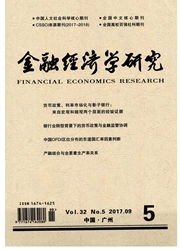

 中文摘要:
中文摘要:
以欧元区为研究对象,通过理论分析和逻辑推理,构建创新型NEO—OCA指数模型,对欧元区成员国的非系统性风险进行测度与量化;同时,对欧元区各成员国的面板数据进行处理分析,得出的结果与现实情况高度符合,验证了NEO—OCA指数的合理性。模型的核心在于:欧元区在当前的运行机制下,各成员国宏观经济的差异性导致了系统整体处于“隐性失衡”状态,各成员国经济中也在积累着非系统性风险;当系统严重失衡时,积累最多风险的国家就会率先爆发危机;危机的爆发是系统释放自身风险的一种形式。最后,以模型为基础,针对欧元区提出了防范和化解危机的主动策略、被动策略、准入策略和内生化策略。
 英文摘要:
英文摘要:
In order to analyze the Eurozone crisis, this paper built innovative NEO - OCA index model to measure and quantify the systemic risk of Eurozone members by theo- retical analysis and logical reasoning. By processing the panel data of Eurozone member states, this paper proved that the outcome of NEO -OCA index is highly consistent with real- ity. The core of the model is that Eurozone is in a state of" hidden imbalances" under the current operating mechanism, and nonsystematic risk is accumulated in members' economic system. When the system was found facing" serious imbalances", the member state with most nonsystematic risk will take the lead in crisis. The outbreak of the crisis is a form of system to release risk. Based on the model,we give some suggestions to guard against the risk. The suggestions include active strategies, passive strategies, access policy and endogenous strate- gies.
 同期刊论文项目
同期刊论文项目
 同项目期刊论文
同项目期刊论文
 期刊信息
期刊信息
